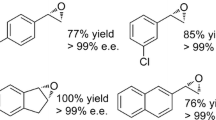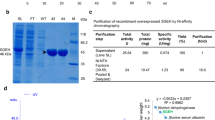Abstract
An enantioconvergent biotransformation of racemic styrene oxide by using two recombinant microbial epoxide hydrolases (EHs) in one pot has been investigated to prepare enantiopure vicinal diols. The recombinant whole cell possessing EH gene from Aspergillus niger LK or Rhodotorula glutinis exhibited a complementary enantioselectivity and regioselectivity, compared to the recombinant cell containing Caulobacter crescentus EH gene. When two recombinant microbial EHs were used in combination, 1.3 g of enantiopure (R)-1,2-phenylethandiol with more than 90% enantiopurity and 95% overall yield was obtained from 1.2 g of racemic styrene oxide in a preparative-scale batch enantioconvergent biotransformation.
Similar content being viewed by others
References
Lee, E. Y. and M. L. Shuler (2007) Molecular engineering of epoxide hydrolase and its application to asymmetric and enantioconvergent hydrolysis. Biotechnol. Bioeng. 98: 318–327.
Archelas, A. and R. Furstoss (2001) Synthetic applications of epoxide hydrolases. Curr. Opin. Chem. Biol. 5:112–119.
Breuer, M., K. Ditrich, T. Habicher, B. Hauer, M. Kesseler, R. Sturmer, and T. Zelinski (2004) Industrial methods for the production of optically active intermediates. Angew. Chem. Int. Ed. Engl. 43: 788–824.
Strauss, U. T., U. Felfer, and K. Faber (1999) Biocatalytic transformation of racemates into chiral building blocks in 100% chemical yield and 100% enantiomeric excess. Tetrahedron Asymmetry 10: 107–117.
Lee, E. Y. (2007) Enantioselective hydrolysis of epichlorohydrin in organic solvents using recombinant epoxide hydrolase. J. Ind. Eng. Chem. 13: 159–162.
Lee, E. Y. (2008) Epoxide hydrolase-mediated enantioconvergent bioconversions to prepare chiral epoxides and alcohols. Biotechnol. Lett. DOI/10.1007/s10529-008-9727-0.
Xu, W., J. H. Xu, J. Pan, O. Gu, and X. Y. Wu (2006) Enantioconvergent hydrolysis of styrene epoxides by newly discovered epoxide hydrolases in mung bean. Org. Lett. 8: 1737–1740.
Cao, L., J. Lee, J. Chen, and T. K. Wood (2006) Enantioconvergent production of (R)-1-phenyl-1,2-ethanediol from styrene oxide by combining the Solanum tuberosum and an evolved Agrobacterium radiobacter AD1 epoxide hydrolases. Biotechnol. Bioeng. 94: 522–529.
Monterde, M. I., M. Lombard, A. Archelas, A. Cronin, M. Arand, and R. Furstoss (2004) Enzymatic transformations. Part 58: Enantioconvergent biohydrolysis of styrene oxide derivatives catalysed by the Solanum tuberosum epoxide hydrolase. Tetrahedron Asymmetry 15:2801–2805.
Hwang, S., H. Hyun, B. Lee, Y. Park, E. Y. Lee, and C. Choi (2006) Purification and characterization of a recombinant Caulobacter crescentus epoxide hydrolase. Biotechnol. Bioprocess Eng. 11: 282–287.
Kim, H. S., S. J. Lee, and E. Y. Lee (2006) Development and characterization of recombinant whole-cell biocatalysts expressing epoxide hydrolase from Rhodotorula glutinis for enantioselective resolution of racemic epoxides. J. Mol. Catal. B 43: 2–8.
Lee, S. J., H. S. Kim, S. J. Kim, S. Park, B. J. Kim, M. L. Shuler, and E. Y. Lee (2007) Cloning, expression and enantioselective hydrolytic catalysis of a microsomal epoxide hydrolase from a marine fish, Mugil cephalus. Biotechnol. Lett. 29: 237–246.
Kim, H. S., O. K. Lee, S. Hwang, B. J. Kim, and E. Y. Lee (2008) Biosynthesis of (R)-phenyl-1,2-ethanediol from racemic styrene oxide by using bacterial and marine fish epoxide hydrolases. Biotechnol. Lett. 30: 127–133.
Hwang, S., C. Y. Choi, and E. Y. Lee (2008) Enantioconvergent bioconversion of p-chlorostyrene oxide to (R)-p-chlorophenyl-1,2-ethandiol by the bacterial epoxide hydrolase of Caulobacter crescentus. Biotechnol. Lett. 30: 1219–1225.
Moussou, P., A. Archelas, J. Baratti, and R. Furstoss (1998) Microbiological transformations. Part 39: Determination of the regioselectivity occurring during oxirane ring opening by epoxide hydrolases: a theoretical analysis and a new method for its determination. Tetrahedron Asymmetry 9: 1539–1547.
Sakai, T., I. Kawabata, T. Kishimoto, T. Ema, and M. Utaka (1997) Enhancement of the enantioselectivity in lipase-catalyzed kinetic resolutions of 3-phenyl-2Hazirine-2-methanol by lowering the temperature to −40°C. J. Org. Chem. 62: 4906–4907.
Yeates, C. A., M. S. Smit, A. L. Botes, J. C. Breytenbach, and H. M. Krieg (2007) Optimisation of the biocatalytic resolution of styrene oxide by whole cells of Rhodotorula glutinis. Enzyme Microb. Technol. 40: 221–227.
Author information
Authors and Affiliations
Corresponding author
Rights and permissions
About this article
Cite this article
Hwang, S., Choi, C.Y. & Lee, E.Y. One-pot biotransformation of racemic styrene oxide into (R)-1,2-phenylethandiol by two recombinant microbial epoxide hydrolases. Biotechnol Bioproc E 13, 453–457 (2008). https://doi.org/10.1007/s12257-008-0153-x
Received:
Accepted:
Published:
Issue Date:
DOI: https://doi.org/10.1007/s12257-008-0153-x




